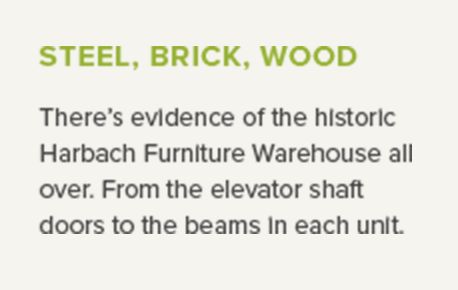Another century, another life for Harbach
The history of the Harbach buildings spans 110 years. Originally, furniture was manufactured in the south building, then warehoused

and shipped from the north building. The south building was acquired in 1989 by local architect Davis Sanders and converted into the ART 316 artist’s studios. In 2014 Kent Mauck, a longtime friend of Sanders, bought the north building with the goal of converting it into loft housing. The idea of reuniting the two structures led Mauck and Sanders to join forces in 2015 to realize their vision of Harbach Lofts.
 and shipped from the north building. The south building was acquired in 1989 by local architect Davis Sanders and converted into the ART 316 artist’s studios. In 2014 Kent Mauck, a longtime friend of Sanders, bought the north building with the goal of converting it into loft housing. The idea of reuniting the two structures led Mauck and Sanders to join forces in 2015 to realize their vision of Harbach Lofts.
and shipped from the north building. The south building was acquired in 1989 by local architect Davis Sanders and converted into the ART 316 artist’s studios. In 2014 Kent Mauck, a longtime friend of Sanders, bought the north building with the goal of converting it into loft housing. The idea of reuniting the two structures led Mauck and Sanders to join forces in 2015 to realize their vision of Harbach Lofts.

